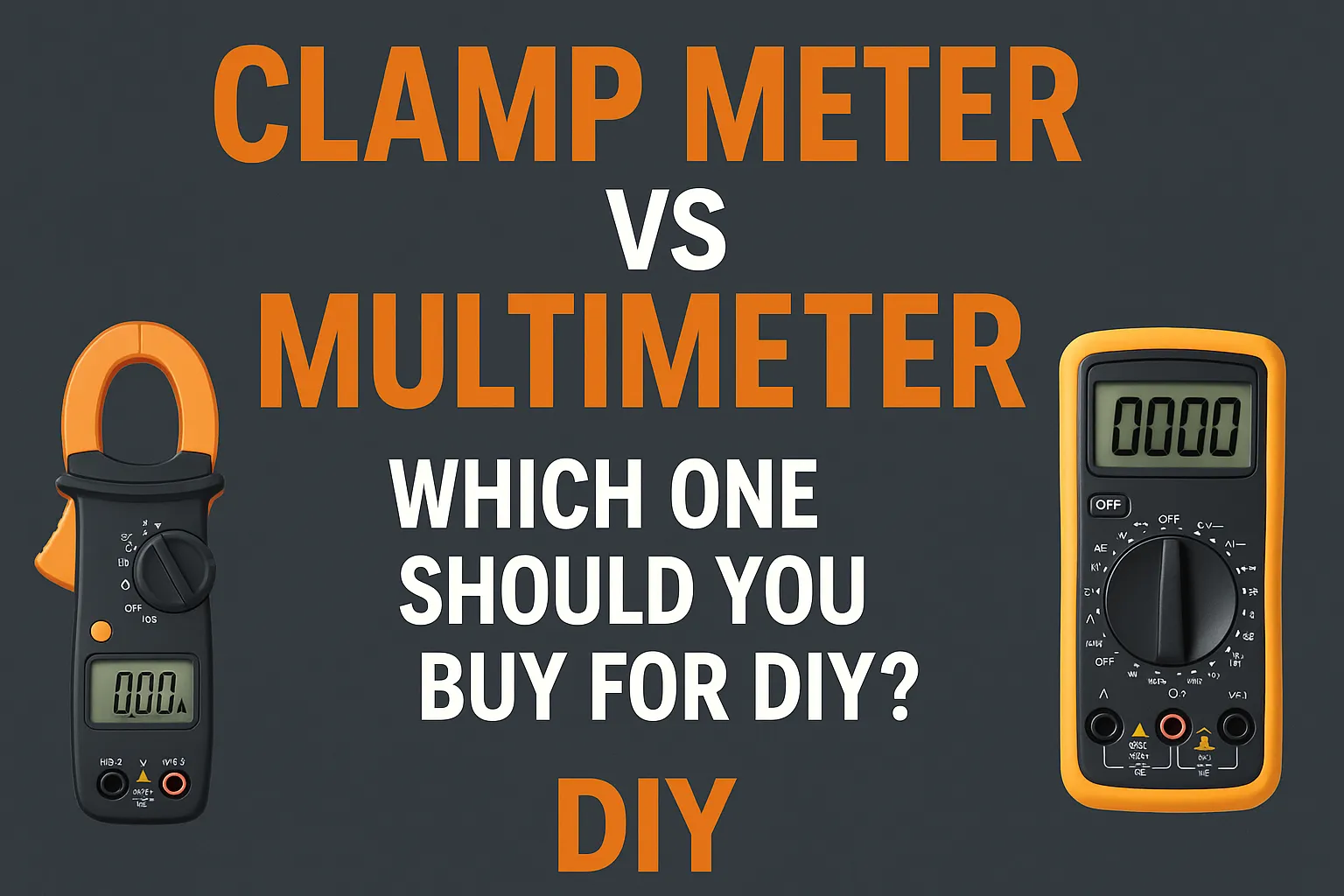Clamp Meter vs Multimeter – it’s a common question for anyone getting into DIY electrical work. If you’re diving into home repairs or automotive diagnostics, you’ve likely seen both tools. They often look similar, they both measure electrical values, and they’re both essential for diagnosing problems. But they aren’t interchangeable.
In this guide, we’ll break down the key differences between clamp meters and multimeters, explain when to use each tool, and help you decide which one is best for your DIY needs in 2025.

What is a Clamp Meter?
A clamp meter is a handheld electrical testing tool primarily used to measure current (amperage) without needing to make direct contact with live wires or break the circuit. It does this through a pair of jaws that clamp around a single conductor.
Key Functions:
- Measures AC or AC/DC current (depending on model)
- Some models also measure voltage, resistance, and continuity
- Often includes features like True RMS, Inrush Current, and Non-Contact Voltage Detection (NCV)
Advantages:
- Safe current measurement – no need to cut or disconnect wires
- Ideal for HVAC, automotive, and home panels
- Faster and safer when working with high current
What is a Multimeter?
A multimeter (often digital multimeter or DMM) is a versatile instrument that can measure multiple electrical values:
Key Functions:
- Voltage (AC/DC)
- Resistance (Ohms)
- Continuity
- Some models also measure current (but require wiring in series)
Advantages:
- All-in-one tool for diagnosing most household electrical issues
- More precise for low-current measurements
- Essential for electronics, small repairs, or low-voltage circuits
In short, a multimeter is your go-to tool when precision and versatility matter, especially when dealing with low-voltage electronics or component-level diagnostics.
Key Differences: Clamp Meter vs Multimeter

Let’s take a closer look at how these tools differ in terms of design, usage, and function:
| Feature | Clamp Meter | Multimeter |
|---|---|---|
| Primary Use | Measuring current | Measuring voltage, resistance, continuity |
| How Current is Measured | Non-contact (via clamp) | Requires wiring in series |
| Voltage Measurement | Available on some models | Standard feature |
| Precision (Low Current) | Lower precision | Higher precision |
| Safety | Safer for high current | Safer for low voltage |
| Ease of Use | Clamp and read | More manual setup |
| Best For | HVAC, automotive, high-load circuits | Electronics, small appliances, wiring checks |
While both are valuable tools, each serves a different niche. Clamp meters shine in high-current situations, while multimeters provide broader functionality for lower-voltage or detailed diagnostics.
Which One Should You Use?
Here’s a breakdown based on common DIY scenarios:
- 🔌 Fixing outlets or light switches? → Use a multimeter for voltage and continuity checks.
- 🔋 Testing batteries or fuses? → Use a multimeter for DC voltage.
- ⚡ Measuring current in home electrical panels or HVAC units? → Use a clamp meter.
- 🚗 Diagnosing your car’s alternator or battery draw? → A clamp meter with DC current measurement is ideal.
- 🧰 General home use? → A multimeter covers 90% of common tasks.
If you’re only measuring current, especially in high-load systems, a clamp meter is safer and quicker. But for versatility and precision in low-voltage circuits, the multimeter is king.
Can You Use Both?
Absolutely—and many experienced DIYers do.
In fact, many electrical professionals keep both tools in their kit. Having a clamp meter and a multimeter allows you to:
- Safely measure high current without opening the circuit (clamp meter)
- Perform detailed checks on voltage, resistance, and electronics (multimeter)
If your budget allows, owning both tools gives you the best of both worlds. Or, you can opt for hybrid models that offer clamp current measurement and multimeter functionality—but these are often more expensive.
FAQs
Q: Can I use a clamp meter like a multimeter?
A: Only partially. Clamp meters can measure current easily, but most models lack the full range of voltage, resistance, and continuity tests that multimeters offer.
Q: Are clamp meters safer than multimeters?
A: For high-current measurements, yes. Clamp meters allow non-contact current testing, which reduces the risk of shock.
Q: Do I need both a clamp meter and a multimeter?
A: If you do a wide range of DIY electrical work, having both will make your toolbox far more versatile.
Q: Can beginners use clamp meters?
A: Absolutely. They’re simple to use and often safer for measuring current than traditional multimeters.
Final Thoughts
Both clamp meters and multimeters are powerful tools—but they serve different purposes. If you frequently work around household wiring, car electronics, or HVAC systems, knowing the strengths of each tool will help you choose wisely.
You can absolutely buy either of these tools from any store or platform you like. But if you choose to purchase through the affiliate links in this article, you’ll pay the same price—nothing extra. What’s more, you’ll be helping support this website and the little joys I try to provide for my soon-to-be-born daughter. Thank you for reading!
👉 Ready to decide? Check out our top picks for Clamp Meters for DIYers and Multimeters for Home Use to get started.
*Disclosure: This post contains affiliate links. If you buy through them, we may earn a small commission at no extra cost to you.*

